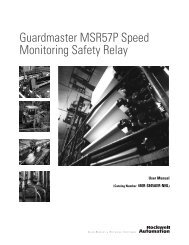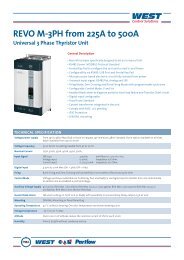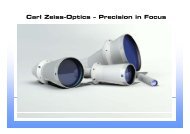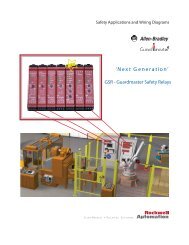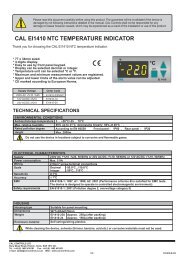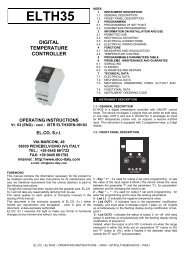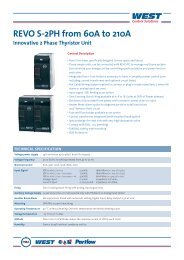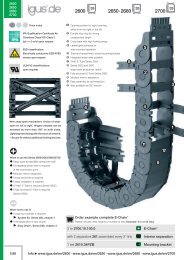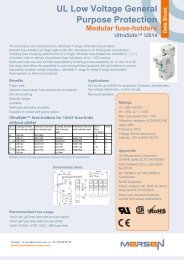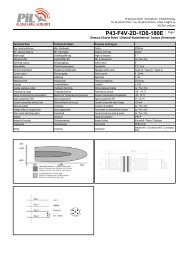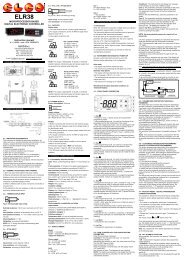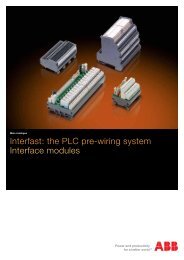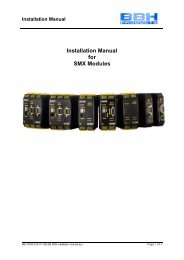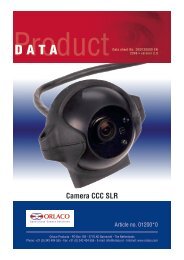ELTH17 - OEM Automatic AB
ELTH17 - OEM Automatic AB
ELTH17 - OEM Automatic AB
Create successful ePaper yourself
Turn your PDF publications into a flip-book with our unique Google optimized e-Paper software.
Exit from the Set programming mode happens automatically without<br />
pressing any button for round about 5 seconds, then the display will<br />
go back to the normal operating mode.<br />
The maximum value of set point that we can code, depends if we<br />
use instrument’s or external probe and on minimum or maximum<br />
programmed differential.<br />
Instrument’s probe: min.-20°…..max +65°C<br />
External probe: min.-35°….max+98°C<br />
Maximum programmable value=set point + positive differential<br />
Minimum programmable value=set point - negative differential<br />
Example: with 5°C positive differential, the maximum programmable<br />
set-point will be of 60°C with probe on instrument and 93°C with<br />
external probe.<br />
With 5°C negative differential, the minimum programmable set-point<br />
will be of -15°C with probe on instrument and -30°C with external<br />
probe.<br />
2.2 - PARAMETERS PROGRAMMING<br />
To enter the working parameters of instrument, we need to press<br />
“ + “ and “ – “ buttons simultaneously and to keep them pressed for<br />
5 seconds, after whom the display will visualize the code that<br />
identify the first parameter and with “ + “ button will be possible to<br />
select the parameter that we intend to modify.<br />
Once we have selected the wished parameter, press “ – “ button , “<br />
out1 “ led will light up and the display will visualize parameter’s<br />
code and its setting can be modified by “ + “ button.<br />
Once the whished value is programmed , press “ - “ button : the<br />
new value will be saved and the display will visualize once again the<br />
code of the selected parameter and “ out1 “ led will turn off.<br />
Working on “ + “ button then, it will be possible to select another<br />
parameter and modify it as described above.<br />
To exit the programming mode keep “ + “ and “ – “ buttons<br />
pressed simultaneously for 3 sec. till to exit the way of<br />
programming. During the set-point programming (flashing display )<br />
we can not enter parameters’ programming.<br />
3 - INFORMATION ON INSTALLATION AND USE<br />
3.1 - PERMITTED USE<br />
The instrument CANNOT be used in dangerous environments<br />
(flammable or explosive) without adequate protection. The installer<br />
must ensure that EMC rules are respected, also after the instrument<br />
installation, if necessary using proper filters. Whenever a failure or a<br />
malfunction of the device may cause dangerous situations for<br />
persons, thing or animals, please remember that the plant has to be<br />
equipped with additional devices which will guarantee safety.<br />
3.2 - MECHANICAL MOUNTING<br />
The instrument, in case 1 DIN Modules, is designed for mounting on<br />
DIN OMEGA rail.<br />
Avoid placing the instrument in environments with very high<br />
humidity levels or dirt that may create condensation or introduction<br />
of conductive substances into the instrument.<br />
Ensure adequate ventilation to the instrument and avoid installation<br />
in containers that house devices which may overheat or which may<br />
cause the instrument to function at a higher temperature than the<br />
one permitted and declared.<br />
Connect the instrument as far away as possible from sources of<br />
electromagnetic disturbances such as motors, power relays, relays,<br />
solenoid valves, etc.<br />
3.3 - ELECTRICAL CONNECTION<br />
Carry out the electrical wiring by connecting only one wire to each<br />
terminal, according to the following diagram, checking that the<br />
power supply is the same as that indicated on the instrument and<br />
that the load current absorption is no higher than the maximum<br />
electricity current permitted.<br />
As the instrument is built-in equipment with permanent connection<br />
inside housing, it is not equipped with either switches or internal<br />
devices to protect against overload of current: the installation will<br />
include an overload protection and a two-phase circuit-breaker,<br />
placed as near as possible to the instrument, and located in a<br />
position that can easily be reached by the user and marked as<br />
instrument disconnecting device which interrupts the power supply<br />
to the equipment.<br />
It is also recommended that the supply of all the electrical circuits<br />
connected to the instrument must be protect properly, using devices<br />
(ex. fuses) proportionate to the circulating currents.<br />
It is strongly recommended that cables with proper insulation,<br />
according to the working voltages and temperatures, be used.<br />
Furthermore, the input cable of the probe has to be kept separate<br />
from line voltage wiring. If the input cable of the probe is screened, it<br />
has to be connected to the ground with only one side.<br />
For the power supply it’s recommended to use an external<br />
transformer TRE, or with equivalent features, and to use only one<br />
transformer for each instrument because there is no insulation<br />
between supply and input. For the probe it is recommended to<br />
use an isolated NTC.<br />
We recommend that a check should be made that the parameters<br />
are those desired and that the application functions correctly before<br />
connecting the outputs to the actuators so as to avoid<br />
malfunctioning that may cause irregularities in the plant that could<br />
cause damage to people, things or animals.<br />
EL.CO. S.r.l. and its legal representatives do not assume any<br />
responsibility for any damage to people, things or animals<br />
deriving from violation, wrong or improper use or in any case<br />
not in compliance with the instrument’s features.<br />
3.4 - ELECTRICAL WIRING DIAGRAM<br />
PS. The neutral must always be connected to terminal A2<br />
4 - FUNCTIONS<br />
A1<br />
12-30VAC/DC<br />
200-240VAC<br />
<strong>ELTH17</strong><br />
NTC<br />
1 2<br />
OUT 1<br />
8A-250V AC1<br />
A2 18 15 16<br />
(isolated)<br />
4.1 - MEASURING AND VISUALIZATION<br />
The instrument only works with a NTC probe( 10K 25°C)<br />
Through “A” parameter is possible to choice whether working with<br />
the probe on the instrument or with an external probe ( AI :<br />
instrument one– AE : external one).<br />
If during the setting of parameters we switch from external probe<br />
“AE” to the instrument’s one “AI”, it’s necessary to programme<br />
set-point once again, seeing that the working temperature range<br />
changes depending on the way of using the probe. The instrument<br />
allows the measure’s calibration, which can be used in order to<br />
adjust the device once again by “ H ” par, on the basis of<br />
application necessities.<br />
PS. Wait 3 minutes before checking the correct measurement of<br />
temperature.<br />
4.2 - TEMPERATURE CONTROL<br />
The regulating mode of instrument is ON/OFF type and it works on<br />
OUT output depending on the probe’s measure, on the Set Point<br />
and on the negative“ B “ or positive “ C “ operating differential.<br />
EL.CO. –<strong>ELTH17</strong> – OPERATING INSTRUCTIONS – VR03 – ISTR <strong>ELTH17</strong>EN-08103 – PAG.2



